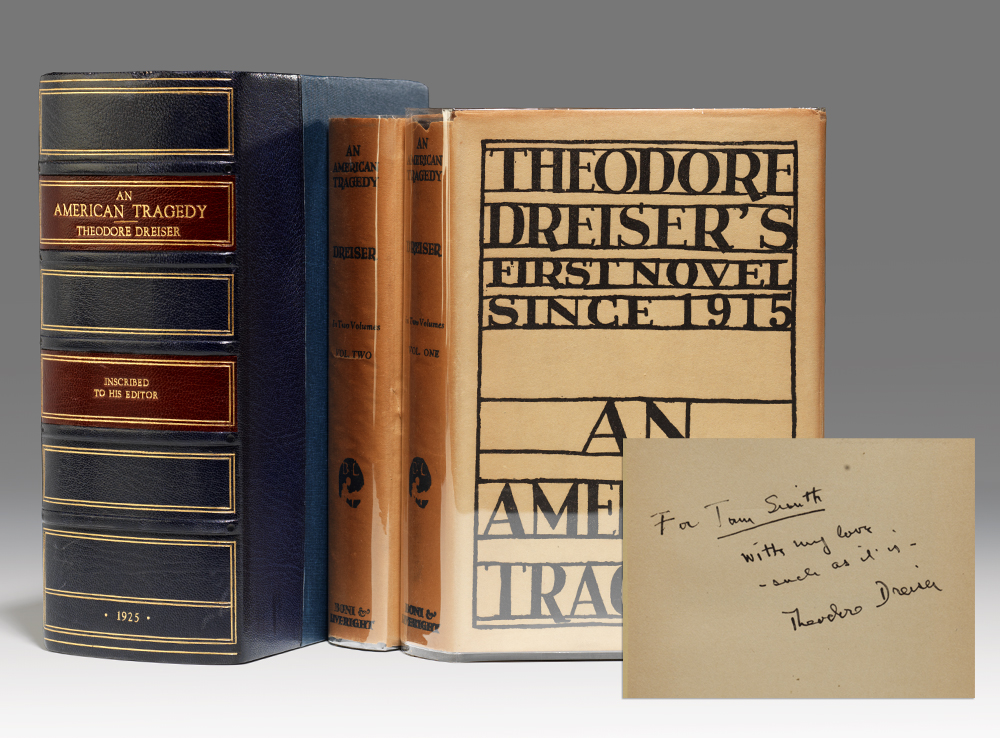Description
“WITH ALL MY LOVE—SUCH AS IT IS”: FIRST ISSUE, EXCEPTIONAL PRESENTATION/ASSOCIATION COPY, OF DREISER’S MASTERPIECE, AN AMERICAN TRAGEDY, WARMLY INSCRIBED BY THEODORE DREISER TO HIS EDITOR
DREISER, Theodore. An American Tragedy. New York: Boni & Liveright, 1925. Two volumes. Octavo, original black cloth, original dust jackets. Housed in a custom chemise and half morocco slipcase.
First edition, first issue, presentation/association copy, of Dreiser’s controversial classic, in scarce dust jackets, warmly inscribed by Dreiser to his editor in Volume I: “For Tom Smith, with all my love—such as it is—Theodore Dreiser.” Smith was largely responsible for the final published version of this classic.
Dreiser based his novel on an actual murder case: in 1906, Chester Gillette “killed his pregnant girl friend Grace Brown when the illicit relationship threatened his getting ahead socially and economically in his small town in upstate New York… [Dreiser’s] final title emphasized his painstaking demonstration that the false values of American society were more responsible for the crime than the individual will” (DAB). “The greatness of An American Tragedy is that Dreiser took [the sensational Gillette case] and dissolved the violent but meaningless frame of the story into its innumerable constituent episodes: the social condition of murderer and victim and friends; the moments of obsession, doubt and rage; the slowly forming moral hardness; the evasions, the hundred hesitations and velleities; the acts rejected as well as those committed. No such story is truly banal, Dreiser seems to be saying; there is only inadequate representation of what happened” (David Denby). “In 1930, the year D.H. Lawrence died, the seven judges sitting on the highest court of Massachusetts agreed to a man that Dreiser’s 840-page novel An American Tragedy— his most popular book and the one many critics consider Dreiser’s best— was ‘obscene, indecent and manifestly tending to corrupt the morals of youth” (de Grazia 98). “The irony is that, while the trial was in progress, the novel was required reading across the Charles River in a Harvard University English course” (Karolides, Bald & Sova, 269). Dreiser did not publish another novel for two decades. The novel served as the basis for the 1951 film A Place in the Sun. This trade edition was published approximately one month before the signed limited issue. First issue, in original black cloth with Boni & Liveright imprint. McDonald 18A. Orton 34. Marshall, 48. Banned Books, 81. Without scarce, fragile original cardboard slipcase. This presentation copy is inscribed to Dreiser’s editor at Liveright, Tom R. Smith. “An erudite, cherubic man who wore a pince-nez… Smith often invited Dreiser to the legendary parties Liveright gave at the four-story brownstone at West Forty-eighth Street, which had become the firm’s offices in 1923. The alcoholic excesses and hedonism of the time foamed over into novels… Dreiser was not impervious” (Lingeman, 395). There was, however, also a serious side to Smith’s association with Dreiser. Dreiser had refused to work with Liveright on any editorial matters and Smith became one of his primary editors on An American Tragedy. In fact, he was frequently the last editor through whom pages flowed. Smith was also a gatekeeper. He cut 50,000 words from the final draft of An American Tragedy. Dreiser angrily returned much of the cut text, but there is little doubt that changes Dreiser accepted improved the novel immeasurably. Despite their editorial conflict, Smith was one of Dreiser’s staunchest supporters. When Dreiser had doubts about the success of his book—he had faced difficulty securing dust jacket blurbs and received a few harsh critical reviews—Smith was the first to reassure him that the book was a success with the public. Indeed, this inscription seems to reflect their complicated professional relationship and the close friendship that supported it. Bookseller tickets.
Books near-fine, with inner paper hinge split, small expert repair to spine cloth of Volume I, and only slightest rubbing and toning to cloth. Extremely scarce dust jackets generally quite fresh and fine. A beautiful copy of this important American novel, exceptionally rare inscribed and with such a desirable association.


